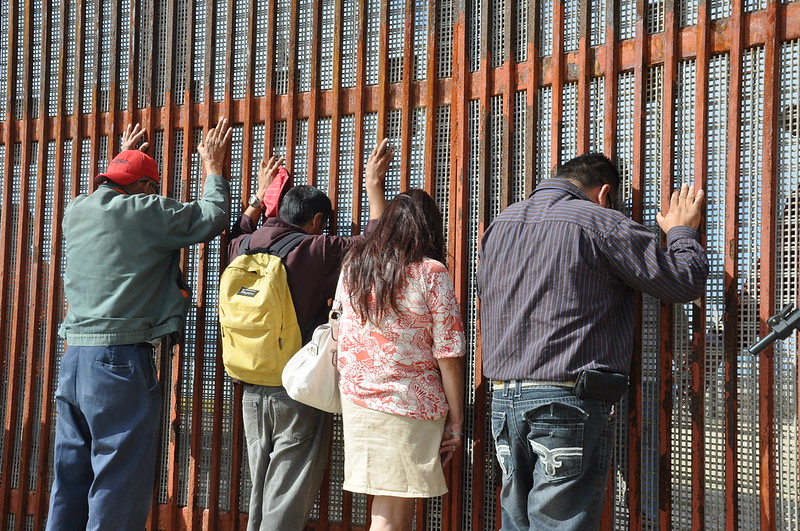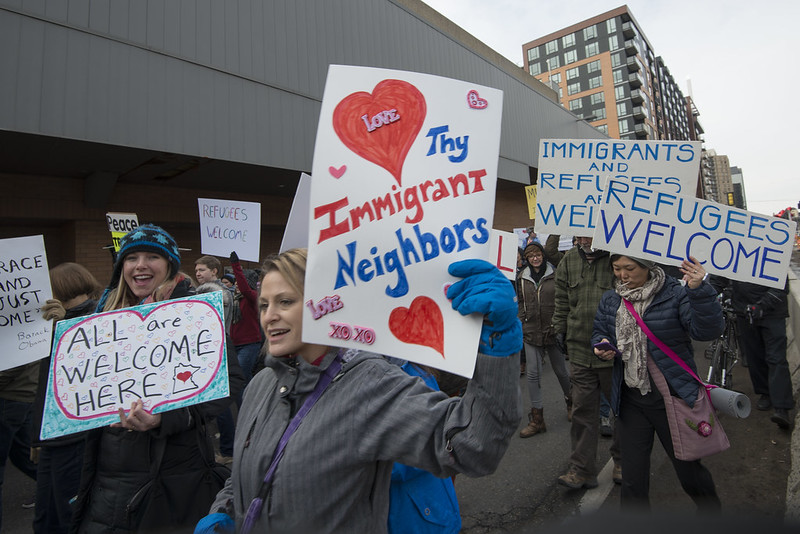A recent Supreme Court ruling allows the Trump administration to deport to Mexico thousands of migrants who have waited months to present legitimate claims for asylum. During a recent investigative trip with the Women’s Refugee Commission, I met many of these desperate would-be immigrants—who suffered inhumane living conditions in detention centers on both sides of the border.
The day we attended hearings in a San Diego immigration court, the judge postponed every asylum case on his docket—10 in a row—and reset them for January 2020. Most of the claimants had not been able to secure the aid of an attorney, as the judge had suggested during their previous hearings. A few of the claimants who showed up for their appointments had their cases postponed because the government attorney from Immigration and Customs Enforcement (ICE) had not brought the correct files to the court room. Frustration and disillusion showed in their expressions of helplessness.

A young man from Central America told the judge that he had called many attorneys listed on a sheet the court had given him, but not one would take his case. Pro bono attorneys and legal service organizations have been overwhelmed with requests. When the judge reset his case for January 28, he expressed concern that his work permit would expire on September 3, and he didn’t know how he would survive.
Instead of sending the National Guard to the Texas border and creating additional hurdles to protection—such as restricting access to ports of entry (metering) and the Migrant Protection Protocols (MPP), known as the Remain in Mexico Program—the Trump administration should have focused on creating an efficient processing system that ensured due process and fairness. Important steps could have included recruiting and deploying an army of pro bono attorneys and using alternatives to detention.
Instead, the administration’s actions caused chaos, confusion and even larger numbers of asylum seekers who are restricted from accessing attorneys or even the basic due process of law they deserve.
When I spoke with the ICE attorney—the government prosecutor in immigration cases—during a recess, he told me that this court had been hearing up to 20 cases a day. “We have to get rid of these cases,” he said, “because next week we will get 40 to 60 cases a day.” He explained that the Trump administration wanted to push thousands of claimants back to Mexico under his new MPP policy; this was just prior to the recent Supreme Court ruling, which will now allow a massive rejection of asylum applications without a court hearing or opportunity to present their case.
Mexico’s asylum system will not be able to handle the onslaught. It received 21,000 asylum cases in 2018. During the first eight months of 2019, Mexico’s courts were inundated with 60 to 70 thousand cases, and now there will be tens of thousands more. The enormous influx of traumatized and indigent people, by any definition a humanitarian crisis, is sure to have a destabilizing impact on Mexico’s civil society. Already, countless migrants have been living on the streets in Tijuana for months, vulnerable to human traffickers and other criminals. The potential for human rights abuse is enormous.
During this investigative trip, the most troubling experience for me happened at Otay Mesa, a new prison located near San Diego built and owned by a private corporation called CoreCivic, which is headquartered in Nashville, TN. I was shocked to learn that a thousand of the nearly 1,400 prisoners being held there were migrants, mostly from West Africa and Central America.
ICE has been managing about two-thirds of this high security incarceration facility and paying $138 per day for each of the 966 emigrants being held here—more than $2,000 per month of taxpayer dollars. (U.S. Marshals supervised “regular” prisoners in a different part of the complex.) This represented a substantial profit for the private corporation. The term “prison industrial complex” popped into my head, and I vowed to look into its lobbying impact on Capitol Hill.
After touring the facility, we looked into the female A, B and C “pods,” each of which held up to 124 women. Sleeping cells with four sets of bunk beds lined the second floor of these living units. Eight women were locked into each cell at night. An exterior “exercise” space consisted of a concrete floor enclosed by three walls that reached at least 12 feet high. The sky could be viewed only by looking up.
I had expected to see migrants from Central America at Otay Mesa—but we were surprised to learn that the facility was also housing 150 migrants from Cameroon in West Africa, which had recently experienced extreme violence and the exodus of a half million people. The Francophone country is located south and east of Nigeria; in the fall of 2017, English-speaking regions declared independence and rebelled against the government. President Paul Biya declared war against the separatists and ordered that they be crushed. Cameroon had received little attention in our media, given the plethora of global chaos.
The Women’s Refugee Commission requested an opportunity to speak with individual women prisoners in privacy, hoping that a few would be willing to share their stories with us. When we entered the large industrial dining room at the end of our tour, we found 80 women waiting, each wearing the dark blue uniform of a “low-risk” prisoner. About 60 were Cameroonian English speakers, and the rest were Latinas. We divided the women by language, and the 12 members of our delegation spread out in order to interview as many as time allowed.
When I sat down at a round table, 10 black women crowded around me, each eager to talk about the long and treacherous journeys they had survived since fleeing extreme violence at home. These women talked about having been attacked by both police and their French-speaking neighbors. One described how her store was destroyed, and she was raped and tortured in the back of a truck. She fled the country, taking nothing.
In telling their stories, I have changed their names to protect their identity.
Alice traced the long journey she took through 14 countries—including Nigeria and Benin, Ethiopia, Brazil, Peru, Ecuador, Colombia and Panama—traveling by foot, airplane, bus and boat. She had been raped in the jungle in Panama, she said, and her friend killed by wild animals.
I took notes, not worrying about the order or questioning the logic of the itinerary she described, but noting the trauma that obviously still consumed her. Later I thought about the Trump administration’s order that migrants must seek asylum in the first country they pass through that has capacity to help them. That requirement is divorced from the experience of traumatized migrants in flight.

Although they had not traveled together, several of these women had met up along the route. They also encountered and trekked with migrants from Haiti, Bangladesh and other countries. Mimi, who complained that she needed medication for high blood pressure, said she saw a boat loaded with refugees being capsized “on the high seas, with no survivors.”
The women criticized the prison’s lack of fresh food, the cold temperature of the air conditioning and the fact everyone around them got sick, but the nurse just told them to drink more water.
“We have no money to buy phone cards for international calls or to find a lawyer,” Betta, her hair stacked in circles like a crown of cornrows, told me. “I don’t know why I am here, when I will get out, or where I can go.” Before arriving here three months ago, she had spent a month in Tijuana and two weeks at the San Ysidro Port of Entry. “My aunt lives in Maryland,” she said, “but they won’t let me go to her. The judge said I am a flight risk, but where else could I go?”
Given the brutal situations in Cameroon, Honduras and elsewhere, many of these migrants should receive temporary protective status (TPS) under international law. Customs and Border Patrol facilities are meant to be holding facilities for up to 72 hours. Otay Mesa, under the supervision of ICE, is truly a prison.
During the tour, an ICE official had told us that detainees usually come here straight from the port of entry and stay an average of 80 days. But Alice said she had been here for 14 months, with no end in sight. “We came here because we believed that America respects our rights,” she said. “We were robbed, raped and exploited by gangs. We watched our friends and family members be killed. But we always believed in America.”
Early the next morning we drove to the San Ysidro Port of Entry and walked across to the Mexico side, where desperate emigrants from scores of countries have gathered every morning for months, hoping to enter the land of freedom and democracy. Surely, they hoped, their numbers would be called today. A few leaders among would-be immigrants had brought order to the chaotic situation by creating a “List.” They recorded names of asylum seekers, roughly in the order of their arrival, and assigned them numbers, up to ten people for each number. The process gives asylum seekers some sense of when their number might be called, whether weeks or months in the future.
Near the gate, three list keepers were recording new names in a large ledger book while waiting for officials on the U.S. side to announce how many they would allow to enter. That day, they called out 20 numbers through a small bullhorn and carefully read the names listed under each number.
The people with lucky numbers picked up their children and bundles of belongings, if they had any, and walked down the fence line to the gate. After all they had survived, the walk to the port of entry must have seemed short. No doubt they believed that their journey had ended, but it was just beginning.
After the last name was called, a diminutive woman who had been next in line picked up her toddler son and approached the list keeper. He shook his head, and the young woman slumped in dejection. She wore all black, except for the bright red design on her Minnie Mouse backpack.
That cheerful souvenir of Disneyland, perhaps given by a shelter, seemed incongruous in this setting, where desperate migrants teetered daily from hope to despair. I hoped that some would reach the Tomorrowland of their dreams.
But for the vast majority, even before the Supreme Court ruling, I knew they were entering Fantasyland.





